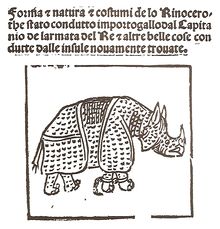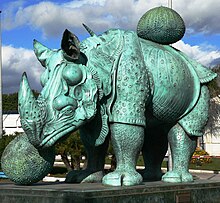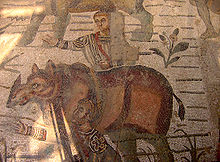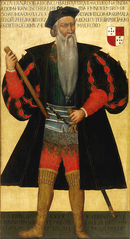Rhinocerus
Rhinocerus is the title of a graphic work by Albrecht Dürer from 1515.
The woodcut sets from India originating rhinoceros is that in 1515 after Lisbon had arrived and from there in the same year on a trip to Rome was sent, where it did not arrive alive after a shipwreck. Dürer never saw the rhinoceros himself; the woodcut is based on a description and sketch by an unknown artist who had inspected the animal.
The Indian rhinoceros
The rhinoceros pictured was most likely the first living specimen of its kind since the 3rd century to be seen in Europe ; Evidence shows rhinos in the game reserves of rulers of Rome, Domitian , Commodus and Caracalla owned animals of this kind. Dürer's woodcut, due to the armor-like expression of the pachyderm, probably contributed significantly to the fact that the Asiatic Rhinoceros unicornis was called "Indian rhinoceros" in German. Up until the second half of the 18th century, its depiction was considered to be a true-to-life reproduction, and the woodcut was copied, reprinted and sold several times. It was only when the rhinoceros Clara was shown in Europe in the 1740s and 1750s that images that had been made from life began to come into circulation.
Gift from East Asia
On May 20, 1515, a rhinoceros landed in the port of Lisbon; it was the most unusual import of the sea route to India that had only existed for a few years . The Portuguese had succeeded where Columbus had failed; They followed the West African coast in the footsteps of earlier Portuguese sailors, circled the Cape of Good Hope and reached India after crossing the Arabian Sea in 1498. In the following decades Portugal played an essential role in the lucrative spice trade. Under the leadership of Afonso de Albuquerque, the Portuguese conquered Goa, which belonged to India, in November 1510 and made it their most important trading post; another fifty fortified settlements along India's west coast served as trading bases. The exchange of official gifts accompanied the negotiations with the local rulers.
Afonso de Albuquerque, the representative of the Portuguese crown in India, received the rhinoceros at the beginning of 1514 from Sultan Muzafar II, the ruler of Cambay (in today's Gujarat ) as part of such a diplomatic exchange of gifts. De Albuquerque decided to give the rhinoceros, in the local language ganda , as a gift to his king, Manuel I of Portugal . On board the "Nossa Senhora da Ajuda" and accompanied by two other Portuguese ships, the rhinoceros left Goa with his Indian guard Ocem in January 1515 and sailed for Lisbon with short stays in Mozambique , St. Helena and the Azores . After a sea voyage of 120 days, the rhinoceros was brought ashore near the Belem Tower, which was under construction . The tower was later given the sculpture of a rhinoceros head on its northwest side.
The exotic animal was housed in King Manuel I's menagerie in the Ribeira Palace in Lisbon. Manuel I owned an extensive menagerie that also included elephants. Rhinos had not been seen alive in Europe for centuries and rather assumed the status of a mythical being. On June 3, 1515, Manuel I let a young elephant and the rhinoceros collide to check Pliny the Elder's report that elephants and rhinos were bitter opponents. Under the eyes of a large and noisy crowd that had gathered to witness this spectacle, the rhinoceros moved slowly and purposefully towards its opponent. The young elephant, on the other hand, confused by the din of the unfamiliar crowd, fled in a panic from the battlefield before an argument broke out between the two animals.


Gift to Pope Leo X.
The rhino remained until the end of 1515 part of the menagerie of Manuel I. Then it was as a gift to the Medici -Pope Leo X. passed. Manuel I wanted to secure the Pope's goodwill. In the 1494 Treaty of Tordesillas Pope Alexander VI. , a predecessor of Leo X., set a border about 370 miles west of the Azores as a demarcation line between the Spanish and Portuguese colonial empires. The American continent was thus divided. However, it was not sufficiently clarified where this demarcation line ran in East Asia - but this was decisive for the question of what share Spain and Portugal would have in the lucrative spice trade with East Asia. With regard to this border between the areas of influence of the two countries, the Pope again played a decisive role - reason enough to secure his favor with gifts. In 1514 Manuel I had already given the Pope the Indian elephant Hanno as a present.
The rhinoceros of Lisbon had already become known there before his trip to Rome. The Florentine physician and poet Giovanni Giacomo Penni had a treatise in verse entitled shortly after the arrival of the animal in Lisbon Forma e natura e costumi de lo Rinocerothe written. This was published in Rome in July 1515 and only a single copy has survived, which is in the Bibliotheca Colombina in Seville . The title page contains a woodcut of a rhinoceros.
In December 1515 the rhinoceros was given a new collar, it was given a “green velvet collar with roses and gold-plated eyelets” and a “chain of gold-plated iron”. “Decorated with fringes”, it was sent by ship to Rome along with other valuable gifts, such as silverware and spices. The journey was briefly interrupted before Marseille . The French King Francis I , who was in Provence at the time, had wished to take a look at the exotic animal. On January 24th, the pachyderm was presented to him with all kinds of pomp on the island of Château d'If in the bay of Marseille.
It was the last time the Indian rhinoceros set foot on land. In a storm the sailing ship crashed on the Ligurian coast north of La Spezia ; the rhinoceros chained to the deck drowned. The carcass was washed up a little later on the coast near Villefranche ; the skin came back to Lisbon. Stuffed with straw and properly assembled, the animal was sent back to Rome, where it did not arrive until February 1516.
Afterlife
The preparation did not attract the attention that had been paid to the living rhinoceros in Lisbon. Nonetheless, Giovanni da Udine painted the rhinoceros for the Pope in a corner of Baldassini's Palazzo and Raffael later put another picture after the exhibit in a painting for the loggias of the Papal Palace in the Vatican.
The whereabouts of the stuffed rhinoceros is unclear; This uncertainty was the inspiration for the 1996 novel The Pope's Rhinoceros by Lawrence Norfolk . There is no evidence to support the assumption that the Medici had it brought to Florence for their natural history collection . The University Museum La Specola in Florence has a stuffed hippopotamus and a lion specimen, acquired by the Medici in the 18th century; but there is no reference to a rhinoceros in any of the five Florentine natural history collections. It may have been destroyed when Rome was sacked in 1527. Hardly verifiable, but often encountered is the assumption that the preparation is still in the Vatican.
In the fifth book of his Gargantua , François Rabelais (1483 / 1494–1553) set a literary monument to a rhinoceros that Heinrich Klerberg had “once shown” to him; he thought it was hardly any different from a boar. The informant can be identified as Johannes Kleberger, a merchant from Nuremberg who lived in Lyon at the same time as Rabelais and was known as a friend of the arts; In 1526 he had Dürer paint him.
Dürer's woodcut
- The history and technique of the woodcut is described in detail in the main article Woodcut .
Valentim Fernandes , who comes from Moravia and lives in Lisbon, saw the rhino shortly after it arrived in the Portuguese capital and described it in a letter to a friend in Nuremberg in June 1515. The original letter, written in German, has not been preserved. A copy in Italian is kept in the Biblioteca Nazionale Centrale in Florence . A second letter from an unknown sender with a sketch was sent from Lisbon to Nuremberg around the same time and served as information about the appearance of the wild animal, noted at the top of the picture by Dürer's woodcut.
The creation of the woodcut
Based on these two sources, Dürer made two drawings. After the second drawing, the printing block for the woodcut was created. Dürer probably did not make it himself, but instead commissioned a "form cutter" to create the printing block based on the drawing. Pear wood was probably used - soft enough to enable fine-grained reproduction, but hard enough to ensure a sufficient number of prints for business success.
In his workshop, founded in 1495, Dürer printed his graphics himself and in stock. They were sold through dealers who sold his prints at trade fairs and markets. Dürer's decision to reproduce the animal in a woodcut rather than a copper engraving was possibly based on a commercial calculation. Copper engravings are more time-consuming and therefore significantly more expensive than wood prints, but the wooden printing block wears out faster than the metal one. The depiction of a rhinoceros was an unusual subject; because customers usually asked for pictures with religious subjects. So it might have been important to keep the sheet affordable.
Details of the woodcut
The woodcut bears the following inscription:
“Purted after Christ. 1513. Jar. Adi. j. May. If the mighty Kunig from Portugall Emanuell to Lysabona has been splendid out of India / I shall have a living animal. They call that rhinocerus. This is hye with all its form Abcondertfet. It has the color of a speckled turtle. Vnd is almost solid covered by thick shells. Vnd is larger in size than Helfandt Aber nydertrechtiger von Paynen / vnd almost Werhugtig. It has a sharp, strong horn on the front of the nose / That starts to sharpen it even where it stays. The dosed animal is found dead in the Helffantz. The Helffandt is almost afraid of it / then where it kumbt / so the animal runs with its head between dye demand / and reysts the Helffandt on the pauch and he worries that he may not earn himself. Then the animal is robed / the Helffandt cannot do anything. They also say that the Rhynocerus Schmell / Fraydig and Listig sey. "
Dürer's woodcut contains not only an incorrect arrival date of the rhinoceros in Lisbon, but also an anatomically incorrect representation of the pachyderm. Examples such as his crouching hare or the piece of lawn illustrate Dürer's particular interest in a realistic representation, but again the images of the lion in his early "Hieronymus" woodcuts show incorrect body proportions, so that this exotic animal, according to David Quammen, is more like one too short-clipped spaniel .
Dürer depicts the Indian rhinoceros as if it were, like a medieval knight, armored with an iron armor loosely attached to the body . The transition from the armor plate to the belly plate is similarly reminiscent of the indentations of rivets hammered into metal; however, the seams of the carapace largely coincide with the course of the thick folds of skin of an Indian rhinoceros. Dürer reproduces the surface of the shell as if it were spotted, the added text indicates a color similar to a “speckled” turtle shell. Since the skin of Indian rhinos shows wart-shaped elevations on the hind legs and in the shoulder area, it may be a misinterpretation of the sketch from Lisbon, which has not survived.
The skin on the legs looks scaly and is reminiscent of chain mail , also part of medieval knight armor. In the neck of the animal there is a second, small and twisted horn. This, too, is probably a misinterpretation of the descriptions available to Dürer - none of the five rhino species has a horn on its neck. The Sumatran rhinoceros as well as the white and black rhinoceroses native to Africa have two horns. However, they wear them on their noses and foreheads, and all three types lack the characteristic skin folds. Besides the Indian rhinoceros , only the Java rhinoceros is unicorned and has the skin folds shown. The origin of the Dürer pachyderm can be identified beyond doubt by the similarity of this species with the Indian rhinoceros. The neck horn, called “Dürerhörnlein” in zoology since Heini Hediger, could nevertheless have a real background. Several times, already by Hediger, especially in the white rhinoceros, horny adhesions were documented on this part of the body, which definitely resemble a small horn.
The rhino in the picture of Dürer's contemporaries

Dürer was not the only artist who was inspired by the sensational news of a rhino that had arrived in Europe for a print. Around the same time as Dürer, Hans Burgkmair also made a woodcut in Augsburg . Burgkmair was in correspondence with merchants in Lisbon and Nuremberg. It is unclear, however, whether he had access to the letters and the sketch on which Dürer's woodcut was based. It cannot be ruled out that Burgkmair saw the animal himself. Burgkmair's depiction lacks the second horn depicted by Dürer in the neck; it also shows the shackles that the animal wore. The only replica of the representation of Burgkmair is a carved figure in the choir stalls of the St. Martini Church in Minden .
Another contemporary representation, a drawing, can be found as an illustration on the margin of a page of the prayer book of Emperor Maximilian I. The animal is evidently depicted according to Burgkmair's model, it wears the same ankle cuffs; however, it has been given a detailed background of plants that are reminiscent of Dürer's lawn from 1503, and there is also a second horn on his neck. An inscription from a later period shows Albrecht Altdorfer as a draftsman in a monogram .
distribution
Dürer's woodcut, of which several original prints have survived, was most widely used; Only one copy of Burgkmair's rhinoceros is known today. The first prints of the Dürer woodcut date from 1515 and differ from later ones in that they only have five lines of text in the upper part of the graphic. After Dürer's death, two new editions of the same printing block were made in the 1540s, followed by two more towards the end of the 16th century. These later prints have six lines of text. Copies of Dürer's rhinoceros can be traced back to the 18th century.
The importance of the woodcut in art history



Dürer's anatomically incorrect woodcut remained popular up to the present day and shaped the Central European conception of an Indian rhinoceros until the 18th century, although rhinos living again could be seen in Europe. For eight years, from 1579 to 1587, another Indian rhinoceros was shown in Madrid; another stayed in London from 1684 to 1686.
16./17. century
A rhinoceros, which was obviously based on Dürer's woodcut, was chosen as a landmark by Alexander von Medici (1510–1537) with the motto “non bvelvo sin vencer” - “I will not return without victory”. Dürer's model can also be identified in the sculpture of a rhinoceros, which was located in the lower area of a 21-meter-high obelisk , which Jean Goujon designed on the occasion of the arrival of Henry II in Paris in 1549 and in front of the Saint-Sepulcre church on Rue Saint -Denis had it built. A similar rhinoceros can be found in the image program of one of the bronze doors of Pisa Cathedral at the western entrance.
Dürer's woodcut also appeared as an illustration in a number of scientific texts, such as in Sebastian Munster's “Cosmographia” from 1544, Conrad Gessner's “Historiae Animalium” from 1551 or Edward Topsell's “Histoire of Foure-footed Beastes” from 1607. The predominantly in Antwerp- active Philipp Galle (1537-1612) had made a graphic after the Madrid rhinoceros; however, this illustration was not nearly as widespread as Dürer's woodcut.
18th century
The effect of Dürer's representation on the European conception of the shape of a rhinoceros did not begin to wane until the middle of the 18th century. During this time, Indian rhinos came to Europe again several times. Jean-Baptiste Oudry painted a life-size portrait of Clara , an Indian rhinoceros who traveled with his owner Douwe Mout van der Meer through several European countries from 1746 to 1758. By George Stubbs 's portrait comes a rhinoceros, which in 1790 in the menagerie of the Tower of London was held. Both paintings were more lifelike than Dürer's woodcut and gradually replaced his view of an Indian rhinoceros. This was particularly due to the fact that Oudry's painting by Clara served as a template for an illustration in Buffon's "Histoire naturelle", published in 44 volumes from 1749, a natural history that has been successful throughout Europe .
Modern

In Germany, Dürer's rhinoceros remained particularly present as an illustration in school books since the 19th century; until the 1930s it was sometimes even considered a faithful representation of a rhinoceros. Today it is used in art classes in general schools as a template for studying graphic means of expression. In modern art, Dürer's rhinoceros inspired Salvador Dalí's 1956 sculpture Rinoceronte vestido con puntillas , which has been installed in Marbella since 2004 .
Umberto Eco noted in 1968 that Dürer's picture of a rhinoceros also appears "in the books of explorers and zoologists", "who have seen real rhinos and know that they do not have tiles like tiles". Compared to a photograph, says Eco, Dürer's pressure seems ridiculous, “but if we examined the rhinoceros skin up close, we would discover such an amount of wrinkles that in certain respects (e.g. when comparing human skin and the skin of the rhinoceros) Dürer's graphic reinforcement would appear much more realistic ”.
Neil MacGregor included Dürer's print as the 75th object in the History of the World in 100 Objects project of the British Museum and the BBC - on the one hand because Dürer's anatomically free representation shaped the European conception of this exotic animal for so long, and on the other hand because the original The animal given to the Portuguese conquerors , can be seen as a symbol of European expansion .
literature
- Silvano A. Bedini: The Pope's elephant . Stuttgart 2006, pp. 139–169: Das unelige Rhinozeros , p. 228 ff .: Memories and reflections , ISBN 978-3-608-94025-1 .
- TH Clarke: The Rhinoceros from Dürer to Stubbs 1515-1799 . London 1986, Chapter 1: The first Lisbon or 'Dürer Rhinoceros' of 1515 .
- Karl Giehlow : Contributions to the genesis of the prayer book of Emperor Maximilian I. In: Yearbook of the art historical collections of the very highest imperial family . Volume XX, Vienna 1899, pp. 59-71.
- Daniel Hahn: The Tower Menagerie . Simon & Schuster UK, London 2003, ISBN 0-7434-8388-X .
- Pliny Secundus the Elder: Natural History. Latin-German . Ed. And transl. by Roderich König in collaboration with Gerhard Winkler. Book 8: Zoologie, Landtiere , Munich 1976.
- David Quammen : The two horns of the rhinoceros. Curious and other stories about the relationship between humans and nature . List, Munich 2004, ISBN 3-548-60382-3 (paperback edition).
- Dieter Salzgeber: Albrecht Dürer: The rhinoceros . Rowohlt, Reinbek 1999, ISBN 3-499-20843-1 .
Web links
Remarks
- ↑ Bedini p. 143f.
- ↑ For the background, subject matter and course of the negotiations de Albuquerque and Muzafar II. See Bedini, pp. 140f.
- ↑ Pliny: Naturalis historia VIII, xxix, 71 ( online )
- ↑ Bedini, pp. 146-150; Hahn, p. 92
- ^ Loggia on the second floor of the Palazzo Pontifici , Vatican
- ↑ See Bedini p. 151ff .; the woodcut is also shown there.
- ^ John Shearman: The Florentine Entrata of Leo X., 1515 . In: Journal of the Warburg and Courtauld Institutes , Vol. 38, 1975; Pp. 152-155; quoted from: Bedini p. 157
- ↑ Bedini, pp. 158-160
- ↑ Cf. Bedini, p. 162 f.
- ↑ Cf. u. a. Bedini, p. 164f.
- ↑ German: A rhinoceros for the Pope . published in 1998
- ↑ Bedini, pp. 165-169; in particular note 39 (p. 292)
- ^ François Rabelais: Gargantua and Pantagruel . 2 Bde. Insel Published by Frankfurt am Main, 1987; Vol. 2, p. 286. See Bedini, p. 231ff.
- ↑ Quammen, p. 283
- ↑ Hediger, A Life with Animals, 1990, p. 349
- ↑ Hediger, Zoological Gardens - Yesterday this morning, 1977 (photo of a Dürer horn with a white rhinoceros)
- ↑ Hediger, article in Der Zoologischer Garten, 1970
- ^ Bedini, p. 234
- ↑ Bedini, p. 151, illus. P. 153; Giehlow, p. 59ff. Bedini doubts the assignment of the drawing from the prayer book to Altdorfer.
- ↑ Bedini, p. 151
- ↑ Giulia Bartrum particularly describes the early print (2002) in the British Museum : Albrecht Dürer and his legacy: the graphic work of a Renaissance artist. British Museum Press, 2002, ISBN 978-0-7141-2633-3 . Also shown in Neil MacGregor , A History of the World in 100 Objects . Translated from the English by Waltraut Götting. Andreas Wirthensohn, Annabell Zettel, CH Beck, Munich 2011, ISBN 978-3-406-62147-5 , pp. 558f. See the inventory of the British Museum (1895,0122.714) .
- ↑ From: James Parsons: The natural history of the rhinoceros, which Doctor Parsons wrote in a letter to Martin Folkes ... and provided with reliable illustrations, and was translated from English into German by GL Kuth . Stein and Raspe: Nuremberg, 1747
- ↑ Bedini, pp. 228-235
- ↑ Figure see here
- ↑ Figure see here
- ↑ See Clarke, p. 20
- ^ Umberto Eco, La struttura assente , Milan 1968; quoted from the German edition: Introduction to Semiotics . Fink: Munich, 1972; P. 211f.
- ^ Transcription of the BBC radio broadcast on September 17, 2010 ; accessed January 14, 2020.








